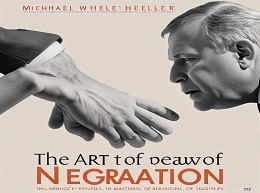The Art of Negotiation

The Power of Persuasion
In "The Art of Negotiation" by Michael Wheeler, readers are introduced to the essential principles and strategies for mastering the delicate art of negotiation. This review delves into the key insights and practical techniques outlined in the book, supplemented with engaging examples to illustrate their application in real-life negotiation scenarios.
Understanding the Dynamics: Navigating the Negotiation Landscape
Wheeler begins by exploring the fundamental dynamics of negotiation, emphasizing the importance of preparation, communication, and flexibility in achieving successful outcomes. By understanding the interests, motivations, and constraints of both parties, negotiators can identify common ground and create value through mutually beneficial agreements. For example, in the negotiation for the release of hostages, understanding the priorities of both the hostage-taker and the authorities can lead to a peaceful resolution that satisfies both parties.
Building Rapport: Establishing Trust and Connection
Central to successful negotiation is the ability to build rapport and establish trust with the other party. Wheeler emphasizes the importance of active listening, empathy, and authenticity in fostering a positive and collaborative negotiation environment. By demonstrating respect and understanding for the perspectives and concerns of the other party, negotiators can lay the foundation for productive dialogue and consensus-building. For instance, in business negotiations, establishing a personal connection with counterparts can lead to stronger relationships and more favorable outcomes in the long run.
Crafting Persuasive Arguments: The Power of Influence
Effective negotiation requires the ability to craft persuasive arguments and communicate one's interests and objectives effectively. Wheeler explores techniques for framing proposals, making concessions, and leveraging sources of power and influence to achieve desired outcomes. By presenting compelling arguments supported by evidence and logic, negotiators can persuade the other party to reconsider their positions and reach mutually acceptable agreements. For example, in labor negotiations, union leaders may use the threat of strike action as leverage to secure better wages and working conditions for their members.
Managing Conflict: Turning Challenges into Opportunities
Conflict is an inevitable part of the negotiation process, but it can also present opportunities for creative problem-solving and innovation. Wheeler offers strategies for managing conflict constructively, including active listening, reframing, and seeking win-win solutions that address the underlying interests of both parties. By reframing conflicts as opportunities for collaboration and value creation, negotiators can transform adversarial relationships into partnerships based on trust and cooperation. For example, in international diplomacy, skilled negotiators may use shuttle diplomacy and backchannel negotiations to defuse tensions and facilitate peaceful resolutions to conflicts.
Closing the Deal: Securing Agreement and Commitment
The final stage of negotiation involves closing the deal and securing agreement on the terms and conditions of the agreement. Wheeler provides guidance on navigating the negotiation endgame, overcoming impasses, and finalizing agreements in a manner that preserves relationships and promotes long-term cooperation. By clarifying expectations, addressing any remaining concerns, and obtaining commitment from both parties, negotiators can ensure that agreements are implemented effectively and sustainably. For example, in contract negotiations, parties may engage in final rounds of bargaining to resolve outstanding issues and reach a mutually acceptable compromise.
Mastering the Art of Negotiation
"The Art of Negotiation" by Michael Wheeler offers a comprehensive guide to mastering the essential skills and strategies needed to succeed in negotiation. By understanding the dynamics of negotiation, building rapport, crafting persuasive arguments, managing conflict, and closing the deal effectively, negotiators can achieve successful outcomes and build stronger relationships with counterparts. Whether in business, politics, or everyday life, the principles outlined in this book provide invaluable insights into the art and science of negotiation, empowering readers to navigate complex situations with confidence and skill.













